What are the pests and diseases of grapes
Vineyard cultivation is a business that requires knowledge and skills. At different stages of growth and development, from the moment of planting the seedling to the moment of fruiting, there are various diseases and pests of grapes. Most often, their appearance is associated with improper care of the culture.
- Classification of diseases
- Bacterial
- Bacterial cancer
- Bacteriosis (Pierce's disease)
- Fungal
- Mildew (downy mildew)
- Oidium (powdery mildew)
- Anthracnose
- Phomopsis (black spot)
- Cercospora
- Alternaria
- Gray rot
- Rubella
- Viral
- Shortcut
- Grooved wood
- Veined mosaic
- Rolling the leaves
- Pests
- Mite
- Leaf roll
- Thrips
- Mealybug
- Miner moth
- Conclusion
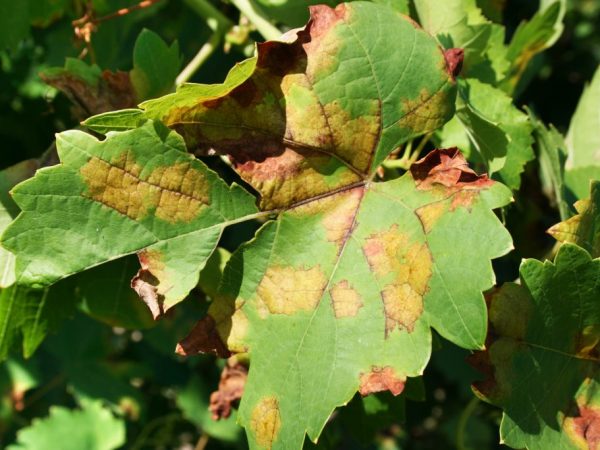
Pests and diseases of grapes
Classification of diseases
Diseases of grapes are divided into types, depending on what pathogen they are caused by:
- bacterial;
- viral;
- fungal.
Bacterial
According to the description, the defeat of bacterial diseases occurs at any stage of plant growth and development. In the fight against bacterial diseases of grapes, chemical, physical-mechanical and biological methods are used, depending on which pathogen is affected by the vineyard.
Bacterial cancer
Plants with open parts of the grape trunk are susceptible to this disease. An air bubble forms under the bark, which expands over time and breaks the bark. The peak of development occurs in autumn or winter.
Prevention against bacterial cancer consists in providing reliable protection for seedlings and adult bushes from frost and mechanical damage.
At an advanced stage, bacterial cancer is not cured. At the initial stage, the plants are fed with phosphorus-potassium fertilizers, which increase the regenerative functions of plants.
In addition, bacterial cancer is treated with a solution of wood ash: 400 g of the substance is consumed per 10 liters of water.
Bacteriosis (Pierce's disease)
This disease, caused by bacteria, affects any part of the plant. Often, infection occurs throughout the bush. The signs of this infection are clearly visible on the fetus. The berries become covered with brown spots, begin to rot and dry out. The pathogen penetrates through the wounds on the vines. The peak of development occurs during the growing season of the bushes.
Prevention is aimed at high-quality pruning, protecting plants from mechanical damage, frost.
Fungal
A large number of fungal diseases are affected by grapes.
Mildew (downy mildew)
This is the most common disease caused by fungal infections. Not only shoots and leaves are affected, but also fruits. Signs of infestation are oily, round spots on the leaf surface. Over time, a white powdery coating appears on their underside. Then necrosis develops: the leaves turn yellow, become red-brown, dry out and die off.
Downy mildew spreads quickly, spreading to inflorescences and ovaries. Such a disease is treated with the help of fungicidal preparations: Bordeaux mixture (1%), cuprozan (0.4%) and polychoma.
In the fight against this disease, other chemical agents have proven themselves well:
- Ridomil;
- Mikal.
Oidium (powdery mildew)
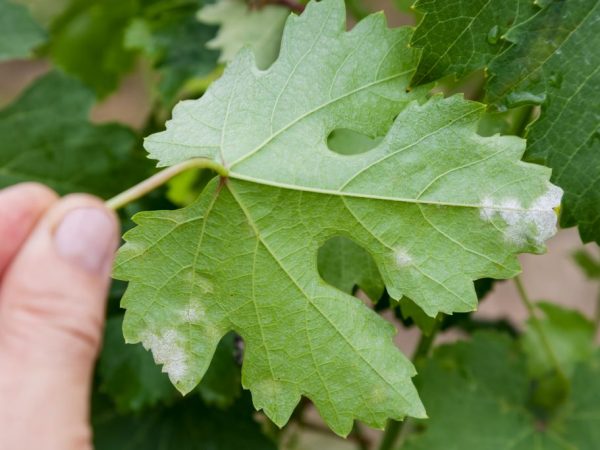
The infected plant can be saved
Oidium is a particularly dangerous fungal disease that affects all parts of the plant, including the fruit. With a strong defeat, the bushes die. Signs - the appearance of white bloom on the surface of the leaves. Then the leaves and shoots are covered with black dots, which merge and cover the entire plant. The bushes affected by powdery mildew shed flower buds.
The disease develops during periods of extreme heat and drought. For the treatment of this disease of grapes, preparations containing colloidal or ground sulfur are used.
The lesions are treated with Topsin, Bayleton, Fundazol or Benleit.
Anthracnose
This disease of grapes is characterized by damage to leaves, shoots, petioles and bunches. Bunches and brushes infected with fungal anthracnose dry up and die. Most often, plants are susceptible to anthracnose before and during flowering. Brown spots appear on the fruit of infected grapes.
This sore spreads to the hands during a period of high humidity: frequent rains in summer.
All affected parts must be removed and incinerated to prevent the spread of the disease. The affected plant is treated with a Bordeaux mixture of 3% concentration.
Also, in the fight against anthracnose, the drugs Switch, Teldor, Arcerid, Polychom, copper oxychloride and Polycarbacin have proven themselves well.
Phomopsis (black spot)
This disease is characterized by the defeat of both young and adult grapes. Signs of vineyard damage appear on the first 7 nodes of annual shoots. Young leaves are covered with brown spot, then the spots merge. The leaf plate has a pronounced white border.
The berries of the ailing bushes acquire a dark purple color, their taste becomes unpleasant, putrid. Ripening vines are covered with a whitish bloom, which grows deep into the wood. Black spot causes sleeves to die off.
Control measures are aimed at optimizing the maintenance and destruction of damaged parts. Prevention consists in treating plants with antifungal drugs: Bordeaux liquid, euparen, ephalem or mical.
Cercospora
This disease manifests itself in summer and affects all mildew resistant varieties. This fungal infection occurs on weakened and old bushes in August. First, the leaves are covered with olive bloom, then turn brown and dry out. Berries crumble at the slightest touch.
Disease control measures are to remove all infected and dried leaves. Subsequent treatment is carried out by treating the bushes with Bordeaux liquid.
Alternaria
This disease is dangerous for both adult and young plants. First of all, bushes with weak immunity are infected. The disease develops in conditions of high humidity and high temperatures.
In appearance, this disease resembles oidium. At the same time, leaves, shoots and berries on the bushes are affected. First, necrotic spots appear, then all parts of the plant are covered with mold.
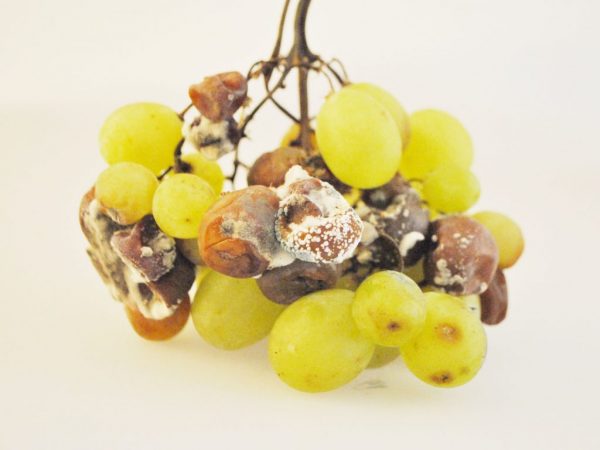
High humidity can be the cause of the disease.
Control measures are the same as for anthracnose. Spraying with Trichodermin also helps.
The disease manifests itself in the second growing season, therefore, preventive methods of plant protection are carried out in the spring. The bushes are treated with Bordeaux liquid or systemic fungicides, which include ridomil. Additionally, during the formation of ovaries, the infected vineyard is treated with the preparation "Skor", "Rapid Gold", "Quadris", "Cabrio-top" or "Kolfugo super".
Gray rot
A dangerous fungal infection that affects the bushes throughout the year. The fungus settles on annual green shoots and leaves.First, these parts of the plant are covered with brown spots, then with a grayish bloom. At the slightest touch, the plaque crumbles like white dust.
At an advanced stage, gray rot spreads to inflorescences, which massively crumble or remain underdeveloped. Also, gray rot affects the fruit. They become covered with a grayish bloom, dry out and die off.
The sore spreads in conditions of high humidity and heat. For the treatment and prevention of plants, the drug "Mikflom" or "Folpan" is used. Processing is carried out in early spring, then during the formation of ovaries and after harvesting.
Some growers use folk remedies for this fungus. Gray rot is removed with soda. A soda solution is used to irrigate the crown of grape bushes during the growing season and at the stage of ovary formation.
Rubella
Rubella affects both white and red grapes. In white varieties, the leaves are first covered with whitish specks, then turn brown at the edges and have a yellow border. In red species, the infected leaves have a bright burgundy color and yellow-green edging. The leaves die off and crumble en masse. Rubella infection occurs in summer in conditions of high air humidity and strong evaporation.
Protection of the vineyard from this sore consists in optimizing the care and seasonal treatment of the bushes with complex preparations - fungicides.
To prevent the spread of the disease, the bushes are regularly fed with organic and mineral fertilizers. Potassium nitrate is added to the depth of the roots.
Chemical treatments are recognized as the most effective rubella control method. A complex treatment is carried out with a Bordeaux mixture (1%) and a polycarbocide solution (0.4%). Also used fungicides of systemic action - "Arcerid", "Topsin", "Silk", "Strobi" or "Ridomil".
Viral
Diseases of grapes caused by a viral infection cause colossal harm to the health of the bushes, and also negatively affect their fruiting, the quantity and quality of the crop.
Shortcut
This is an infectious degeneration of shoots. The deformed vines contain a large number of stepchildren, double knots. The leaves are dissected and contain yellow spots. Chlorosis caused by iron deficiency has the same symptoms.
The leaves covered with yellow gradually die off, dry out, peas and massive shedding of berries begin.
The carrier of the sore is the nematode parasite, therefore, preventive measures are aimed at disinfecting the soil with fungicides. Also, to prevent the development of the disease, healthy planting material is used and diseased plants are removed from the site in a timely manner. Planting seedlings is carried out in sterile soil, which will also prevent the spread of infection and infection of the bushes.
Grooved wood
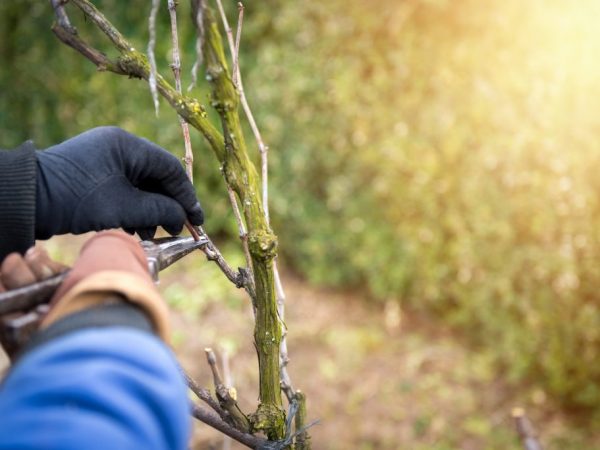
Diseased plants must be removed
Signs of this disease appear on the roots, trunk or sleeves in the form of depressed grooves. Often manifests itself at the sites of vaccinations. The grapes affected by the furrows stop growing and eventually die.
Preventive measures are aimed at the timely removal of diseased bushes and compliance with all agrotechnical rules for growing.
Veined mosaic
Clear signs of this disease are the appearance of light yellow stripes along the main leaf veins. The disease manifests itself during the growing season in late spring or early summer.
On bushes affected by veined mosaic, there is a massive shedding of flower buds, peas and shedding of berries.
This disease is fought in the following way:
- the bushes on which the viral parasites have settled are removed from the site;
- treat the soil from the main carrier - nematodes - with fungicides;
- the immunostimulating drugs "Immunofitofit" or "Novosil" are introduced into the soil.
Rolling the leaves
The causative agent of this infection parasitizes inside the tissues of the plant, clogging up the blood vessels.The peak of the development and manifestation of the sore occurs in the middle of summer. The plastic sheet curls, turns red, while the veins retain their green color. Older leaves are affected first, then the infection spreads to young leaves.
Infected bushes lag behind in growth, reduce the growth of vines and bunches, the ripening of the crop lags behind in terms of time. In brightly colored varieties, the color of the leaves becomes pale green.
Preventive measures - soil treatment with fungicides, removal of diseased specimens from the site.
For the treatment of diseases, biological products are used that increase the immunity of plants - "Novosil" or "Immunocytofit".
Pests
As with fruit trees, there are many pests of grapes. They affect the leaves, shoots, roots and fruits of the plant. The most dangerous of them are:
- ticks;
- miner mole;
- leaf roll;
- thrips;
- worms.
Mite
The mite parasitizes both young and old trees. There are several varieties of the grape mite: European red, spiderweb, and grape felt.
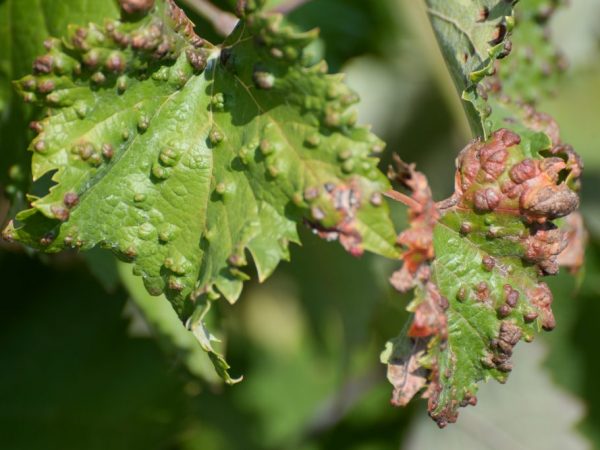
Parasites suck the juice from the leaves
Microscopic insects colonize in spring and summer during periods of drought and extreme heat. The parasites suck the sap from the leaves, resulting in a brownish foliage.
For preventive purposes, the vineyard is regularly inspected and damaged parts are removed in time. The best methods of control are spraying the aerial part with preparations-acaricides "Neoron", "Fufanon" or "Actellik". In order to completely destroy the parasite, three times treatment with an interval of 10 days is required.
Leaf roll
This parasite reproduces at a galloping rate. Leafworm caterpillars eat everything that comes their way: leaves, buds, ovaries and fruits. All affected parts begin to rot. The bunches have an unpleasant appearance.
To prevent the invasion of the parasite from the site, it is worth removing plant debris in time. If insects are found, a complex treatment of the vineyard with insecticides is carried out, after 10 days, spraying is repeated. When caterpillars appear, biological products are used.
Thrips
Thrips cause serious harm to grape leaves. Black, elongated insects feed on foliage sap. You should regularly inspect the vineyard for their presence.
Double treatment with Karbofos or BI-58 helps against thrips. Other chemical agents have proven themselves quite well: "Aktara" and "Fitoverm".
Mealybug
A sucking parasite that, when colonized on a plant, forms a fluffy powdery bloom. Insects affect annual shoots, bunches, foliage. Damaged areas dry out quickly.
It is possible to fight these insects by spraying the bushes with insecticides (Aktellik, Aktara, Fufanon) before the beginning of the growing season and after the appearance of 1-2 pairs of leaves on the shoots.
Miner moth
This parasite significantly reduces the yield and taste of grapes. The larvae - tiny caterpillars of the moth - gnaw through the leaf plate and suck the juice out of it. Affected leaves wilt, dry out and fall off.
In autumn, for the purpose of prevention, a deep digging of the site is carried out, plant residues are removed. If insects are found in the spring, they are treated with insecticides.
Conclusion
Pests and diseases of grapes cause great harm to the entire vineyard. To prevent their appearance, they optimize the care of plants, provide them with regular watering, feeding and periodically inspect for their presence. If you follow these simple rules, you will not have to use chemistry to save your fruit plantations.


